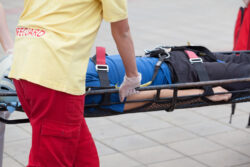Defeating Causation Obstacles in Injury Claims
Proving Negligence Involves Showing Duty, Breach, Causation, and Damages, With Causation Being Particularly Complex.
 When a person is injured in an accident, whether it is a motor vehicle accident, slip and fall, or some other type of accident caused by the negligence of another person, the injured party may be entitled to recover monetary damages to compensate them for their injuries, medical bills, lost wages for time off from work, and even pain and suffering.
When a person is injured in an accident, whether it is a motor vehicle accident, slip and fall, or some other type of accident caused by the negligence of another person, the injured party may be entitled to recover monetary damages to compensate them for their injuries, medical bills, lost wages for time off from work, and even pain and suffering.
Most personal injury claims are based on the legal theory of negligence. To prevail in a negligence claim, the plaintiff (the injured person) must prove four separate elements by a preponderance of the evidence, a legal standard that means the facts alleged are more likely true than not. These four elements include duty, breach, causation, and damages. As a general overview, a defendant breaches a duty of care if they deviate from a standard of care that they were legally obligated to act with. For example, every driver has a duty to drive as a reasonably prudent person under the circumstances. If they fail to do so by texting while driving or running a red light, then they have breached their legal duty.
However, prevailing in a negligence claim does not end there. In fact, duty and breach are sometimes the easier elements to prove. Proving the element of causation or, in other words, that the defendant’s breach of duty was the cause of the plaintiff’s injuries and other damages can involve complex factual, legal, and medical analysis.
Two Types of Causation in Pennsylvania Personal Injury Litigation
Particularly in the context of a motor vehicle accident, many people regard causation as synonymous with “fault”, yet focusing on who was at fault in the accident oversimplifies the element of causation. Causation does not just relate to whose actions made an accident come about, but also whether that accident, rather than some other previous or intervening event, caused a particular injury.
In a Pennsylvania personal injury case, the plaintiff must show that the defendant’s breach of duty was the actual and proximate cause of the plaintiff’s damages. Being the actual cause means that the defendant’s actions were the direct cause or, in other words, “but for” the defendant’s actions, the plaintiff would not have suffered their injuries.
Determining if the defendant’s actions were the proximate cause of the plaintiff’s injuries requires an analysis of whether the defendant could have reasonably foreseen that the defendant’s actions could result in the accident that occurred and the specific injuries that the plaintiff suffered. When it comes to assessing proximate cause, foreseeability is key.
A Practical Example to Examine Foreseeability in Injury Claims
For example, let’s say a store employee spills a bucket of water and fails to clean it up or place warning signs around the area. If a customer slips and falls on the slip and suffers a back injury from the fall, it may be easy to establish that the store’s negligence was the actual and proximate cause of the customer’s injury. The injuries suffered are reasonably foreseeable. However, if that plaintiff had suffered a concussion during the fall, which led to dizziness and blurred vision, and these symptoms caused the plaintiff to crash his car on the way home and suffer further injuries, then the additional injuries are not a foreseeable consequence of failing to clean up the spill at the store.
Disputes Over the Following can Often Arise after Accidents Occur
The strongest personal injury case is one that is supported by clear evidence that is presented in a persuasive manner. The first step in achieving this objective is correctly identifying the issues of a case and potential defenses that may be raised by the defendant. Particularly if you wish to obtain a settlement and avoid a trial, it is important to present a settlement demand to the defendant’s counsel (usually an insurance company) that is supported by compelling evidence and anticipates and preempts potential defenses. If a settlement cannot be reached, this evidence will be essential in court to meet your burden of proof against the defendant.
Commonly Raised Intervening Variables Defenses
Questions regarding causation can also extend beyond the time of the accident. It is very common for the defendant in a personal injury claim to raise the defense that a plaintiff’s symptoms and complaints are the result of an injury that existed prior to the accident in question or an injury that the plaintiff suffered subsequent to the accident. These defenses are raised to prove that, even if the defendant breached a duty of care, the plaintiff’s injuries were not caused by that breach, but rather a prior or subsequent, unrelated accident.
Disputed Details of the Accident Itself
 If details regarding the accident itself are in dispute, evidence like surveillance footage, eyewitness testimony, and an accident reconstruction report may be critical in establishing that the defendant’s negligence was the actual and proximate cause of the accident and plaintiff’s damages.
If details regarding the accident itself are in dispute, evidence like surveillance footage, eyewitness testimony, and an accident reconstruction report may be critical in establishing that the defendant’s negligence was the actual and proximate cause of the accident and plaintiff’s damages.
Challenges to Causation of a Particular Injury
If the causation of a particular injury is at issue, medical records and the opinion of a medical expert may be necessary to prove the connection between the accident and defendant’s injuries, as well as how the accident resulted in the nature and extent of the plaintiff’s injuries. Within medical records, medical providers may have made notes directly opining on causation, or the medical records may be reviewed by an independent medical examiner, who will generate a report and provide an expert opinion on the cause of the plaintiff’s injuries.
Let Our Knowledgeable Northeast Philadelphia Injury Attorneys Help You Prove Causation in Pennsylvania
When you choose to work with our team of skilled and experienced Pennsylvania personal injury lawyers at Cohen & Riechelson, our approach to proving causation will be backed with careful investigation, presentation of a compelling set of evidence, and effective negotiation. To schedule a complimentary review of your case, please contact us today. You can receive a complimentary consultation by dialing (215) 337-4915. We provide help to clients in Yardley, Croydon, Bristol, Bucks County, Buckingham, Warrington, and surrounding areas.
